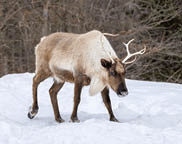Return to 4th Quarter 2023 articles.



Reindeer, or caribou, are designed to live in very cold places. Most mammals in your backyard have a layer of fur, but reindeer have two layers of thick, furry, brownish-gray hair. The layer close to their skin is dense, woolly, and soft. On top are long, hollow hairs called guard hairs. Air gets trapped in this structure, and air is a poor conductor of heat. This arrangement holds in body heat and keeps the reindeer warm in even the coldest climate. This structure also makes the reindeer buoyant so they can float and are excellent swimmers. Reindeer legs do not have the thick fur coat. In cold weather, blood vessels in the legs constrict, causing less blood to flow to avoid heat loss through contact with ice and snow.
Reindeer eyes show incredible engineering to allow them to see as they live in darkness for six months of the year. Reindeer are uniquely able to see ultraviolet light, allowing vision in very dark conditions. They also have an acute sense of smell, allowing them to locate food even under a heavy blanket of snow. Their primary food source is lichen, a simple growth found on tree trunks and rocks everywhere on the planet. Reindeer do not need to hibernate because their food is always available.
Reindeer have incredible stamina, able to travel 35 miles in a single day. They have been clocked at 50 miles per hour, meaning they can outrun any predators in their Arctic environment. Those who invented the Santa Claus myth included reindeer because they had observed these animals in their natural habitat. God has designed animals for every environment on this planet. When you see Christmas decorations showing reindeer pulling Santa’s sled, use that image to teach children about the design God has built into all living things, including reindeer.
Picture credits:
© ms_pics_and_more/Bigstock.com
